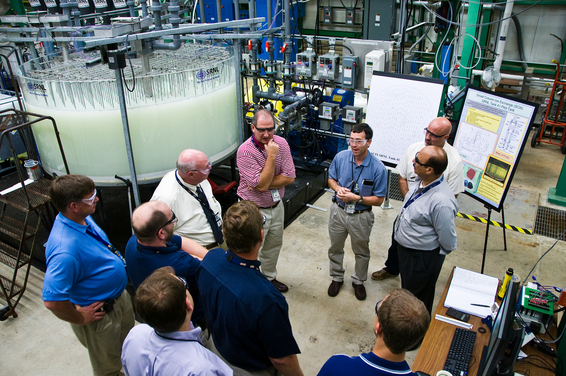EM Performs Tenth Technology Readiness Assessment
WASHINGTON, D.C. – EM recently completed its tenth Technology Readiness Assessment (TRA) since piloting the TRA process in 2006.
A TRA is an intensive peer review process through which the maturity of a technology is evaluated. A TRA utilizes the Technology Readiness Level (TRL) scale pioneered by the National Aeronautics and Space Administration (NASA) and adopted by the United States Air Force and other government organizations, including EM. The project uses the results of the TRA to develop a Technology Maturation Plan (TMP), which details the steps necessary to mature the technology to the level at which it can be deployed.
The EM TRAs to date have focused primarily on technologies to accomplish one of EM’s most pressing concerns: treatment of radioactive waste in aging waste tanks at the Savannah River, Hanford and Idaho sites.
The most recent TRA evaluated Small Column Ion Exchange (SCIX), which is a sorbent column system being developed at the Savannah River Site (SRS) in South Carolina to remove cesium, strontium and select actinides from radioactive salt solutions in waste tanks. With a capacity to process 2.5 million gallons of salt waste annually, SCIX may supplement operations at the Salt Waste Processing Facility under construction at SRS, markedly shortening the life cycle and reducing the risk and cost of tank waste processing.

Employees with Savannah River Remediation, the SRS liquid waste contractor, review mock-ups of the SCIX technology at the Savannah River National Laboratory.
This technology development work at SRS may be used to support treatment operations at other sites.
A TRA team consists of experts in appropriate disciplines who are not involved in development of the technology being evaluated or in the project in which the technology may be deployed.
Hoyt Johnson, EM TRA lead, pointed out that the TRA has evolved from an audit-like process to a more effective collaborative effort in which both the TRA and site teams identify solutions to eliminate gaps in the technology’s development.
“Part of the success of the TRA is the ability of the site team to understand TRA and implement it as a self-assessment. This was exemplified by the SCIX site team’s use of the External Technical Review process at inception, followed by site-level assessment of the technology maturity, resulting in a mature SCIX Technology Maturation Plan available for review when the EM TRA team arrived.” Johnson said. “Sites have become tuned in and more knowledgeable.”
Funding constraints in 2012 have resulted in SCIX development activities being placed on hold. In preparation for resumed funding, the TRA team developed a list of prioritized recommendations for maturing the technologies so that the most effectual and expeditious use of funding is made as it is released, whether incrementally or all at once.
TRAs and TMPs have proven to be effective management tools for reducing technical risk and minimizing potential cost increases and schedule delays. In addition to the TRAs of technologies for tank waste treatment, EM hopes to complete assessments for technologies used in other work, such as decontamination and demolition and soil and groundwater remediation.
EM issued the U.S. DOE Office of Environmental Management TRA/TMP Process Guide in 2008. A revised guide, scheduled to be issued in March, incorporates lessons learned from implementing the TRA process, recognizes the use of the process for areas in addition to tank waste and is more user friendly for site and headquarters review teams.
Complete details concerning all of EM’s TRAs, including summaries and final reports, can be found here.
No comments:
Post a Comment
Note: Only a member of this blog may post a comment.